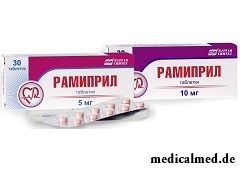





Ramipril
Application instruction:
 Ramipril – inhibitor of an angiotensin-converting enzyme (APF) of long action.
Ramipril – inhibitor of an angiotensin-converting enzyme (APF) of long action.
Form of release and structure
Dosage form – tablets: almost white or white color, a round ploskotsilindrichesky form, with a facet and dividing risky (in a blister strip packaging: on 10 pieces, in a cardboard pack 3 packagings; on 14 pieces, in a cardboard pack 1 or 2 packagings).
– ramiprit active ingredient of Ramipril, in 1 tablet – 2,5 mg, 5 mg or 10 mg.
Auxiliary components: lactose, cellulose microcrystallic, aerosil (silicon dioxide colloid), magnesium stearate, примогель (sodium carboxymethylstarch).
Indications to use
- Combination therapy of chronic heart failure (including with diuretics);
- Arterial hypertension;
- The heart failure which arose during the period from the second to the ninth day after an acute myocardial infarction;
- Clinically expressed and preclinical stages of a diabetic or not diabetic nephropathy (especially with the expressed proteinuria) at a combination to arterial hypertension;
- Decrease in risk of development of a stroke, myocardial infarction or cardiovascular mortality at patients with high cardiovascular risk: at the confirmed coronary heart disease (in the anamnesis with a myocardial infarction or without it), including patients after aortocoronary shunting, transdermal transluminal coronary angioplasty; at a stroke in the anamnesis, occlusal damages of peripheral arteries.
Besides, Ramipril's use is shown by a sick diabetes mellitus in the presence of not less than one accessory factor of risk: arterial hypertension, microalbuminuria, increase in plasma concentration of the general cholesterol, smoking, decrease in plasma concentration of cholesterol of lipoproteins of the high density (HS-LPVP).
Contraindications
- Chronic heart failure in a decompensation stage;
- Hypertrophic subaortic stenosis, hemodynamically significant stenosis of the mitral or aortal valve;
- Arterial hypotension (the systolic arterial pressure (AP) is below 90 mm of a mercury column) or pathology with unstable indicators of a hemodynamics;
- Hereditary or idiopathic Quincke's disease (including the anamnesis, including against the background of the previous therapy by APF inhibitors);
- Syndrome of glyukozo-galaktozny malabsorption, deficit of lactase, lactose intolerance;
- The expressed renal failure (the clearance of creatinine (CC) is less than 20 ml/min.);
- Liver failure;
- Bilateral hemodynamically significant stenosis of renal arteries (in the presence of only one kidney – unilateral);
- Hemodialysis with use of high-flowing membranes with a negatively charged surface;
- Primary hyper aldosteronism;
- Aferez of lipoproteins of low density with use of a dextran of sulfate;
- Simultaneous use of glucocorticosteroids, non-steroidal anti-inflammatory drugs, immunodepressants, cytotoxic drugs for treatment of a nephropathy;
- The accompanying hyposensibilizing therapy of reactions of hypersensitivity to poisons of bees, wasps and other insects;
- Combination therapy with antagonists of receptors of angiotensin II at a diabetic nephropathy;
- Combination to the drugs containing алискирен at patients with a renal failure (KK is less than 60 ml/min.) and a diabetes mellitus;
- Age up to 18 years;
- Period of pregnancy and breastfeeding;
- Hypersensitivity to components of drug or other APF inhibitors.
Besides, Ramipril's use is contraindicated in an acute stage of a myocardial infarction:
- Heart failure of the IV functional class on NYHA classification;
- Pulmonary heart;
- Unstable stenocardia;
- The ventricular disturbances of a heart rhythm posing hazard to life.
With care patients are recommended to appoint drug with atherosclerotic defeats of brain or coronary arteries; at the pathologies interfaced to risk of sharp decrease in the ABP with a renal failure at APF inhibition: the expressed hypertension (especially malignant arterial hypertension), chronic heart failure (especially heavy stage or at reception concerning it other hypotensive medicines), hemodynamically significant unilateral renal artery stenosis at patients with two kidneys, the previous therapy by diuretics, disturbances of water and electrolytic balance (against the background of vomiting, diarrhea, insufficient consumption of table salt and liquid, plentiful sweating); with an abnormal liver function and/or kidneys (KK is more than 20 ml/min.), a diabetes mellitus, a hyperpotassemia, a hyponatremia, general diseases of connecting fabric (including a scleroderma, a system lupus erythematosus, the accompanying therapy by the drugs (risk of oppression of a marrowy hemopoiesis, development of an agranulocytosis or neutropenia) operating on a picture of peripheral blood); at simultaneous use of antagonists of receptors of angiotensin II and/or drugs of an aliskiren at double blockade the system renin-angiotensin-aldosteronovoy (SRAA), at a state after transplantation of a kidney.
Route of administration and dosage
Pill is taken inside to or after food, swallowing entirely, washing down with water.
The doctor appoints a dose on the basis of clinical indications, considering individual portability and therapeutic effect of drug.
The recommended dosing:
- Arterial hypertension: an initial dose – 2,5 mg of 1 times a day (morning) or in 2 receptions. For achievement of desirable therapeutic effect perhaps multiple increase in a dose in 2-3 weeks of treatment. A usual maintenance dose – 2,5-5 mg, maximum – 10 mg a day. At the previous therapy by diuretics them it is necessary to cancel or lower a dose not later than in 3 days prior to Ramipril's reception. An initial dose for the patients accepting diuretics, patients with insufficiency of renal function or with arterial hypertension and heart failure – 1,25 mg a day once. It is necessary to begin use under strict control of the doctor. For patients with the broken water and electrolytic balance or risk of hypotensive reaction the initial daily dose should not exceed 1,25 mg;
- Chronic heart failure: an initial dose – 1,25 mg once, if necessary a dose it is possible to double in 1-2 weeks. The daily dose should not exceed 10 mg. At a concomitant use of diuretics their dose should be lowered prior to therapy;
- The heart failure which arose within 2-9 days after an acute myocardial infarction: an initial dose – on 2,5 mg 2 times a day (in the morning and in the evening) and in two days of therapy – on 5 mg 2 times a day. A maintenance dose – 2,5-5 mg 2 times a day. At bad portability of drug (arterial hypotension) it is necessary to lower an initial dose to 1,25 mg 2 times a day, then in 2 days it can be raised to 2,5 mg, in 2 days – to 5 mg 2 times a day. The daily dose should not exceed 10 mg. At bad portability of a dose on 2,5 mg 2 times a day administration of drug should be cancelled. Because of insufficient experience of use of Ramipril for patients with the expressed heart failure of the III-IV functional class (on NYHA classification) which arose right after an acute myocardial infarction, the initial dose for this category of patients should not exceed 1,25 mg of 1 times a day. Increase in a dose has to be carried out under observation of the doctor;
- Nephropathy at chronic diffusion pathologies of kidneys, a diabetic nephropathy: an initial dose – 1,25 mg once. At good tolerance of drug the dose can be doubled every 2 week before achievement of a maintenance dose of 5 mg of 1 times a day;
- Decrease in risk of development of a stroke, myocardial infarction or cardiovascular mortality at patients with high cardiovascular risk: an initial dose – 2,5 mg once. Gradual increase in a dose is shown: in 1 week, then in 2-3 weeks – to a maintenance dose of 10 mg of 1 times a day.
The recommended mode of dosing of Ramipril for patients with a renal failure:
- KK is less than 30 ml/min.: an initial dose – 1,25 mg a day, maximum – 5 mg;
- KK of 30-60 ml/min.: an initial dose – 2,5 mg a day, maximum – 5 mg;
- KK is more than 60 ml/min.: an initial dose – 2,5 mg a day, maximum – 10 mg.
At a liver failure the initial dose should not exceed 1,25 mg, maximum – 2,5 mg once.
Initial dose for patients of advanced age – 1,25 mg a day.
Special control is required for patients 65 years, accepting diuretics, for patients with chronic heart failure are more senior at an impaired renal function and a liver. The dose is selected depending on the target objective of the ABP.
Side effects
- Cardiovascular system: often – orthostatic hypotension, faints (syncopal states), strong decrease in the ABP; infrequently – peripheral hypostases, heartbeat, rushes of blood to face skin, myocardium ischemia (including development or strengthening of arrhythmia, development of a myocardial infarction or an attack of stenocardia, tachycardia); seldom – a vasculitis, strengthening or emergence of disturbances of peripheric circulation; frequency is unknown – Reynaud's syndrome;
- Respiratory system: often – sinusitis, bronchitis, short wind, the dry cough (amplifying in a prone position and at night); infrequently – a nose congestion, a bronchospasm, weighting of a clinical course of bronchial asthma;
- Nervous system: often – feeling of ease in the head, a headache; infrequently – an ageusia, dizziness, a dysgeusia; seldom – balance disturbance, a tremor; frequency is unknown – disturbance of psychomotor reactions, brain ischemia, disturbance of cerebral circulation (passing), an ischemic stroke, paresthesias, a parosmiya;
- Alimentary system: often – discomfort in a stomach, nausea, vomiting, inflammatory reactions in a stomach and intestines, dyspepsia, diarrhea, digestive disturbances; infrequently – abdominal pains, pancreatitis (in rare instances with a lethal outcome), an intestinal Quincke's disease, a xerostomia, increase in activity in a blood plasma of enzymes of a pancreas, gastritis, a lock; seldom – a glossitis; frequency is unknown – aphthous stomatitis;
- Mental disturbances: infrequently – alarm, drowsiness, the suppressed mood, nervousness, sleep disorders, motive concern; seldom – confusion of consciousness; frequency is unknown – disorders of attention;
- Acoustic organ: seldom – a ring in ears, a hearing disorder;
- Organ of sight: infrequently – an image vagueness, a vision disorder; seldom – conjunctivitis;
- Gepatobiliarny system: infrequently – increase in contents in a blood plasma of the conjugated bilirubin, increase in activity of liver enzymes; seldom – hepatocellular defeats, cholestatic jaundice; frequency is unknown – an acute liver failure, cytolytic or cholestatic hepatitis (it is extremely rare with a lethal outcome);
- Urinary system: infrequently – functional disorder of kidneys, development of an acute renal failure, increase in a diuresis, strengthening of the proteinuria which was (earlier existing) increase in content of creatinine and urea in blood;
- Lymphatic system and system of blood: infrequently – an eosinophilia; seldom – a neutropenia, a leukopenia, an agranulocytosis, decrease in maintenance of erythrocytes in peripheral blood, decrease in level of concentration of hemoglobin, a leukocytosis, thrombocytopenia; frequency is unknown – a pancytopenia, hemolitic anemia, oppression of a marrowy hemopoiesis;
- Mammary glands and reproductive system: infrequently – passing impotence, decrease in a libido; frequency is unknown – a gynecomastia;
- Musculoskeletal system: often – a mialgiya, muscular spasms; infrequently – an arthralgia;
- Dermatological reactions: often – skin rash, infrequently – a hyperhidrosis, a skin itch, a Quincke's disease (including with a lethal outcome); seldom – онихолизис, urticaria, exfoliative dermatitis; very seldom – a photosensitization; frequency is unknown – a multiformny erythema, a toxic epidermal necrolysis, a pempigus, Stephens-Johnson's syndrome, psoriazopodobny dermatitis, weighting of a course of psoriasis, an alopecia, a lichenoid or pemfigoidny dieback or an enantema;
- Immune system: frequency is unknown – anaphylactoid or anaphylactic reactions (including on poisons of insects), increase in maintenance of antinuclear antibodies;
- Metabolism, laboratory indicators, food: often – increase in level of potassium in blood serum; infrequently – a loss of appetite, anorexia; frequency is unknown – decrease in level of sodium in blood;
- General disturbances: often – feeling of fatigue, a stethalgia; infrequently – fervescence; seldom – an adynamy.
Special instructions
Purpose of drug should be made after careful assessment of function of kidneys of the patient. Treatment needs to be accompanied with control of function of kidneys, especially at patients with defeat of renal vessels.
Prior to the beginning of and during Ramipril's use regular control of the ABP, function of kidneys (urea, creatinine), the level of content of potassium and other electrolytes, hemoglobin, activity of liver enzymes is required.
Reception of the first and each increase in a dose have to be carried out under observation of the doctor, it will allow to avoid development of uncontrollable hypotension and other undesirable effects.
Patients with malignant arterial hypertension are recommended to begin treatment in stationary conditions.
In case of increase in level of concentration of creatinine and urea in blood serum at patients with an impaired renal function it is necessary to lower a dose or to cancel drug as development of a hyperpotassemia is possible.
At considerable activity of liver enzymes or emergence of jaundice Ramipril's use should be cancelled.
When developing tranzitorny arterial hypotension administration of drug should be stopped temporarily, after stabilization of the ABP treatment can be continued, repetition of the expressed hypotension is the basis for reduction of a dose or drug withdrawal.
At planned surgery, including dental, the patient has to inform the surgeon and the anesthesiologist on treatment ramiprily not to allow sharp decrease in the ABP means for the general anesthesia. Reception of tablets is recommended to be stopped in 12 hours prior to operation.
During treatment it is regularly necessary to control the level of leukocytes of blood for early detection of possible development of an agranulocytosis or a neutropenia.
The risk of development of a hyperpotassemia in patients with arterial hypertension increases at chronic heart failure, purpose of drugs of potassium, a concomitant use of amiloride, Spironolactonum, Triamterenum (kaliysberegayushchy diuretics).
At emergence in the patient of abdominal pains with nausea and vomiting when carrying out the differential diagnosis it is necessary to consider the possibility of development of an intestinal Quincke's disease.
In case of performing the desensibilizing therapy at stings of poisonous insects APF inhibitors need to be replaced with antihypertensives from other groups.
Emergence of dry cough during treatment can be connected with administration of drug.
Patients are recommended to avoid exercise stresses and influence of high temperatures of air.
During Ramipril's reception patients cannot manage vehicles and mechanisms.
Medicinal interaction
At Ramipril's appointment the doctor has to warn the patient about need of preliminary consultation before simultaneous use of any medicines.
Terms and storage conditions
To store at a temperature up to 25 °C in the place, unavailable to children.
Period of validity – 2 years.
Antidepressant Klomipramin causes an orgasm in 5% of patients.

Each of us faces from time to time that other people need the immediate help. We react to it on-raznomu:...
Section: Articles about health
Any of us is not insured from a heavy illness of the loved one. Happens and so that someone from family members becomes the bed patient, and remains in such state for a long time. It extremely suppresses both the most injured, and all it to...
Section: Articles about health
The stroke is one of the most widespread diseases of the person, annually in the world about 6 million cases of this pathology are registered. According to medical statistics, strokes occur almost three times more often than myocardial infarctions. The disease belongs to heavy, and has an unfavourable result: the lethality reaches 40% among women and 25% among men. A considerable part of the patients who endured a stroke cannot be recovered completely. We suggest readers to examine...
Section: Articles about health
The state of health of the person in many respects depends on chemical composition of biological liquids of an organism. Specialists consider that з...
Section: Articles about health
It is possible to find the extensive range of fruit and vegetables in modern shops. Russians already got used that on counters there is not only a seasonal domestic production, but the vegetables and fruit which are grown up in the countries with more comfortable conditions at all seasons of the year...
Section: Articles about health
All the known slogan "Protect Men!" arose not from scratch. In a sense, the nature created men much less adapted for vital disorders, than it seems at first sight. Statistically, men are ill more often, than women, have the majority of illnesses heavier and earlier die. The situation is aggravated with the fact that our fathers, husbands, brothers and sons are not always inclined to care for the health. Partly it happens because of unwillingness of t...
Section: Articles about health
All of us, unfortunately, should face flu nearly an every year. It would seem, so frequent disease has to be study...
Section: Articles about health
Many of us, probably, noticed more than once that from intellectual loadings at some point the brain as though "overheats" and "assimilation" of information is strongly slowed down. Especially this problem urgent for persons of age becomes more senior than fifty years. "It is already bad with...
Section: Articles about health
More than a half of the married couples which faced prostatitis – leave. The new broadcast "Female View of Prostatitis" will help to learn – whether you have or your relatives problems....
Section: Articles about health
Physical activity is necessary for normal functioning of a human body. At a lack of the movement cease функц...
Section: Articles about health
Statistically, pathologies of a thyroid gland in the world more than 500 million people have. Failures in work of this body lead to heavy disbolism, development of heart diseases, vessels, a reproductive and nervous system. In hard cases excessive...
Section: Articles about health
Today about 30 diseases, sexually transmitted are known. Wide circulation of these illnesses is extremely promoted by the dual attitude towards them: on the one hand, most of people know about "shameful" diseases very little and do not aim at receiving detailed and reliable information, considering that such problems personally will never concern them. With another – there are delusions about STD which instill unreasonable confidence that troubles such...
Section: Articles about health
Each person knows that fervescence is an illness sign. However about existence of diseases can to suite...
Section: Articles about health
Is told about advantage of domestic animals for development of the child much. But many parents nevertheless do not hurry to bring pets as are afraid that they can do harm to health of children. What troubles can really trap kids and how to make with...
Section: Articles about health
Aspirin (acetylsalicylic acid) – one of those drugs which are known literally to all. It is available in each home first-aid kit, and many accept it at the first signs of an indisposition, often without having a fair idea of properties and therapeutic effect of drug. Meanwhile, impact of aspirin on a human body is very various, and is not always favorable. About it it is important to foreknow, in order to avoid emergence of problems with health....
Section: Articles about health
The phenomenon of improvement of a condition of the patients at administration of drugs who are not containing active agents, so-called effect of placebo is known...
Section: Articles about health
History of use of an anesthesia during operations contains more than 160 years. Annually in the world hundreds of thousands of surgical interventions during which to patients the substances immersing them in a dream and saving from pain are entered are carried out. Using an anesthesia to these...
Section: Articles about health
About influence of fasting days on an organism it is told much – both about advantages, and about shortcomings. It is considered that fasting day in the form of a short-term monodiet is useful, promoting effective removal of slags from an organism whereas irregular, excessively long, spontaneous fasting days lead only to deterioration in health. How to derive benefit from the sparing diet and not to do much harm to itself? Let's consider the main advantages and shortcomings of fasting days and their influence on an org...
Section: Articles about health
The main role in development of a peptic ulcer of a stomach and duodenum the bacterium Helikobakter plays pilor. Activity and Wuxi...
Section: Articles about health
The dietology, as well as other sciences, does not stand still. Food stuffs are exposed to comprehensive study, and scientists obtain new information on their properties and influence on a human body. Unfortunately, this reasonable and natural process from time to time д...
Section: Articles about health
Sometimes it seems that modern society was divided into two camps: representatives of the first are sure that only the woman has to be responsible for contraception, representatives of the second, respectively, are sure that it is destiny of men. Meanwhile the question of contraception has very many aspects – both psychological, and legal and, of course, medical....
Section: Articles about health
We live during an advertizing era. Daily each person receives a solid portion of persuasive councils about what to eat to be здо...
Section: Articles about health
EKO, or extracorporal fertilization - a method of treatment of infertility which became the reason of a set of broken-down copies in due time accused the people working on its creation neither more nor less of rivalry good luck. Already very few people deny the rights...
Section: Articles about health
There is an opinion that at low temperatures safety of products is ensured longer and better thanks to what the refrigerator is considered the most suitable place for storage of food. In most cases it is fair, however there is a number of products for which low temperatures – the main reason of their premature damage. Storage in the refrigerator leads to their bystry rotting, emergence of a mold, is followed by loss of vitamins and tastes. What products it is better to remove...
Section: Articles about health
Long time antibiotics were considered as a panacea from all diseases and were appointed even at insignificant symptoms of an infection. Even now...
Section: Articles about health
Shops of household appliances offer us the huge choice of various devices for the house. Whether there are among this abundance devices which not only facilitate house work, but also help to keep health of the person? Of course, and we will tell about them today....
Section: Articles about health
For residents of the countries of Southeast Asia various algas are an obligatory component of a daily diet. Their popularity is connected not only with high tastes, but also with numerous curative properties. Russians are a little familiar with products such that is distressing: algas are so useful that they should be eaten as often as possible. Let's get acquainted closer with useful properties of this seafood....
Section: Articles about health
